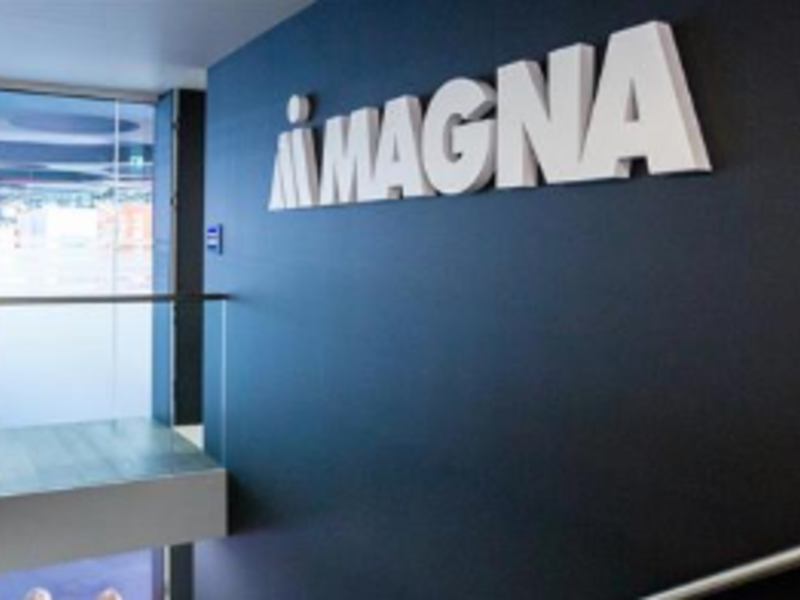
Fourth-quarter net income at Canadian supplier Magna International Inc. surged 68 percent from a year earlier due in part to better-than-anticipated vehicle production.
The company reported net income of $738 million for the quarter ended Dec. 31, compared with $440 million during the same quarter in 2019. Revenue rose 12 percent from a year earlier to $10.57 billion.
Earnings and sales came in ahead of expectations, Magna said, thanks to vehicle production in the quarter being “better than anticipated,” as well as “higher than anticipated equity income” and “strong operating performance.” Global light-vehicle production rose 4 percent from the year-earlier quarter, according to the supplier.
The results reflect the relative resilience of new-vehicle demand in key markets, including North America, amid the COVID-19 pandemic. It was the second straight quarter in which Magna reported hundreds of millions of dollars in net income, after posting a $647 million net loss in the second quarter amid global automotive production shutdowns.
Magna stock closed Friday’s trading in New York up 10.4 percent to $83.27. The stock was trading at all-time high levels during the session and has never closed above $80 per share, according to Yahoo Finance.
“Overall, I believe our second-half results demonstrate Magna’s resilience — we are emerging even stronger from the challenges we faced in 2020,” Magna CEO Swamy Kotagiri said in a statement.
For the year, Magna reported net income of $757 million, down from $1.77 billion in 2019. Revenue fell 17 percent to $32.6 billion, in large part due to pandemic-related production shutdowns in the first half of 2020.
The supplier said it expects net income in 2021 to rise to between $2.1 billion and $2.3 billion on revenue of between $40 billion and $41.6 billion.
“Our outlook reflects a product strategy aligned with sustainability objectives, further growth driven by technologies that support the car of the future, margin expansion and continued strong free cash flow generation.” Kotagiri said.
Magna’s upbeat forecast comes as an automotive chip shortage is forcing carmakers to trim production, with U.S. parts maker Visteon Corp. projecting the crunch could crimp global auto production by 10 to 15 percent in the first half of 2021.
Magna CFO Vince Galifi said the company anticipates “near-term disruptions” in vehicle assembly due to the chip shortage. Magna expects any lost production to be made up in the second half of the year.
Fourth-quarter revenue in Magna’s body exteriors and structures unit gained 12 percent from a year earlier to $4.39 billion. The company said the business benefited in part from the launch of new programs, including the Ford Bronco Sport and Mustang Mach E. Revenue in the fourth quarter of 2019 was negatively impacted by that year’s UAW strike against General Motors.
Revenue in its power and vision unit, which includes powertrains, electronics and mirrors, rose 17 percent to $3.18 billion. That business also benefited from the launch of new programs, including the Mercedes-Benz GLB and Land Rover Defender.
Seating revenue dipped 3 percent to $1.39 billion for the quarter. The company pinned the decline on lower production in “certain key programs,” including Chrysler minivans.
Sales in Magna’s contract vehicle assembly business jumped 20 percent from a year earlier to $1.76 billion. It produced 34,500 vehicles in the fourth quarter of 2020, up 2 percent from 33,900 units in 2019.
Kotagiri said Magna expects 50 percent of the vehicles it builds on contract for automakers will be electric models by 2023. The company anticipates between $6.3 billion and $6.8 billion in sales from its complete vehicle business that year.
Magna Steyr, the company’s contract manufacturing subsidiary, builds vehicles including the Jaguar I-Pace, BMW 5 Series and Mercedes-Benz G-Class. In October, it signed on to build Fisker’s Ocean electric SUV.
Magna has an assembly plant in Austria, as well as one in China as part of a joint venture with BAIC Group and the Zhenjiang government. Kotagiri, who took over as CEO on Jan. 1, said on the analyst call that Magna “would be open” to building vehicles in North America if it made business sense.
“Obviously, there [are] a bunch of variables, whether it’s painted or non-painted and so on and so forth, that will add to the decision process,” he said.
Magna ranks No. 3 on the 2020 Automotive News list of the top 100 global suppliers with worldwide sales to automakers of $39.43 billion in 2019.
Reuters contributed to this report.

